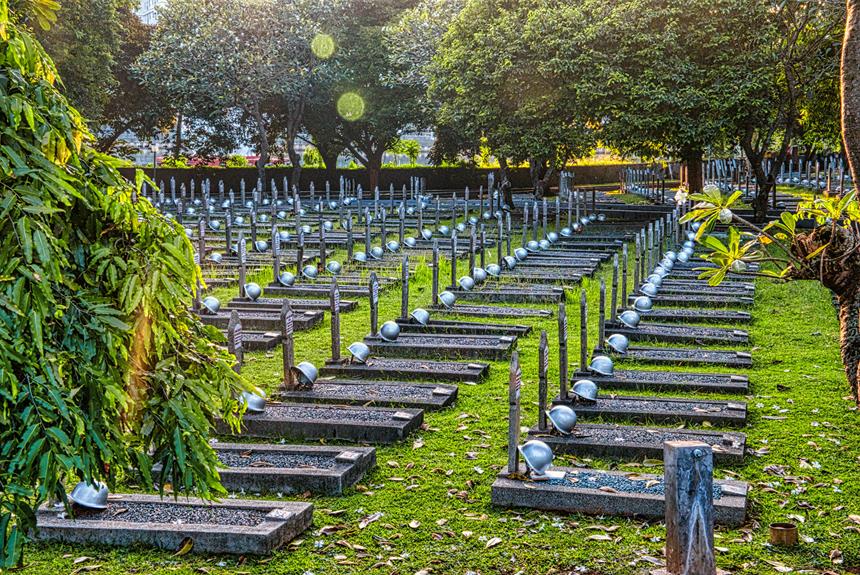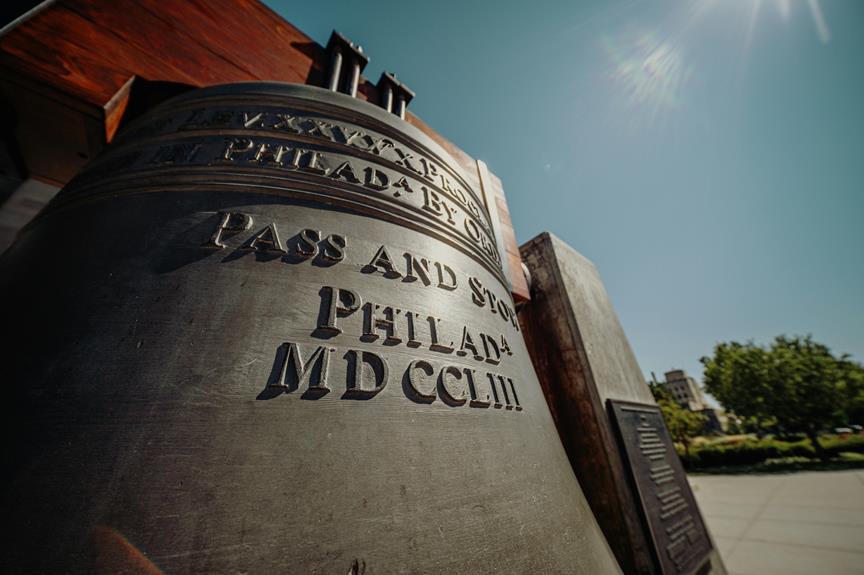The Prisoner of War Museum in Thailand reveals a poignant reminder of the harrowing ordeals endured by prisoners during World War II. Beyond its historical significance, the museum offers a unique opportunity to engage with the personal narratives and artifacts that encapsulate the resilience and human spirit in times of conflict. A visit to this museum not only discloses the untold stories of courage and endurance but also prompts reflection on the broader implications of wartime captivity.
Key Takeaways
- Commemorates POW experiences in WWII, emphasizing resilience and hardships.
- Displays personal artifacts like letters, clothing, and photographs for a tangible connection.
- Offers educational programs and community outreach initiatives for public engagement.
- Shares stories of courage, sacrifice, and resourcefulness in adversity.
- Promotes empathy, understanding, and reconciliation in international relations through shared experiences.
History of the Museum
The history of the Prisoner of War Museum in Thailand traces back to its establishment in 1977 to commemorate and educate visitors about the experiences of prisoners of war during World War II. This museum holds immense cultural significance as it stands as a proof to the resilience and hardships faced by those who were held captive during the war. The origins of the museum lie in the need to honor the memories of those who suffered and to make sure that future generations never forget the atrocities of war.
The Prisoner of War Museum's establishment marked a pivotal moment in Thailand's acknowledgment of the impact of World War II. It serves as a stark reminder of the consequences of conflict and the importance of upholding human rights even in times of turmoil. The cultural significance of the museum is evident in its role as a place of remembrance and education, where visitors can gain insight into the past and reflect on the sacrifices made by prisoners of war.
Exhibits and Artifacts
Numerous relics and items on display at the Prisoner of War Museum in Thailand provide a poignant and tangible connection to the experiences of those held captive during World War II. Through meticulous preservation efforts and advanced conservation techniques, the museum guarantees that these artifacts are maintained in pristine condition for future generations to learn from and reflect upon.
The exhibits within the museum include a wide array of items such as personal belongings, letters, photographs, and even pieces of clothing that belonged to the prisoners of war. Each artifact tells a unique story of resilience, survival, and the enduring human spirit in the face of adversity. Visitors can witness firsthand the harsh conditions faced by the prisoners and gain a deeper understanding of the sacrifices made during this tumultuous period in history.
In addition to showcasing these historical treasures, the Prisoner of War Museum in Thailand also runs educational programs and engages in community outreach initiatives. These programs aim to raise awareness about the importance of preserving the memory of those who suffered during World War II and to promote a message of peace and reconciliation. By involving the community in its mission, the museum fosters a sense of collective responsibility towards honoring the past and shaping a more harmonious future.
Prisoners' Stories
Amidst the artifacts and exhibits that vividly depict the hardship and resilience of prisoners of war during World War II, the poignant narratives of individual captives emerge as powerful affirmations to the human spirit under duress. These survival stories and POW experiences offer a glimpse into the harrowing realities faced by those held in captivity.
Here are four compelling aspects of the prisoners' stories:
- Courage in Adversity: The stories of POWs highlight their unwavering courage in the face of unimaginable challenges. From enduring brutal living conditions to facing constant threats, these individuals exemplified remarkable bravery.
- Resilience and Hope: Despite the harsh circumstances, many prisoners found ways to stay resilient and maintain a sense of hope. Their ability to persevere through the darkest of times serves as a confirmation to the strength of the human spirit.
- Acts of Sacrifice: Many POW accounts recount acts of selflessness and sacrifice, where individuals put the well-being of their fellow captives above their own. These stories of camaraderie and compassion are truly inspiring.
- Survival Strategies: The resourcefulness displayed by prisoners in their quest for survival is both astonishing and humbling. Whether through ingenuity, camaraderie, or sheer determination, these strategies offer valuable insights into the human capacity for adaptation and survival.
Impact on World War II
With lasting repercussions across global theaters of conflict, the impact of the Prisoner of War Museum in Thailand on World War II underscores the enduring legacy of wartime captivity experiences. The museum serves as a poignant reminder of the challenges faced by prisoners of war (POWs) during the war, shedding light on the harsh realities and sacrifices made by those held in captivity. By showcasing artifacts, personal accounts, and historical documents, the museum brings to life the harrowing POW experiences that shaped the course of the war.
Furthermore, the museum's role in fostering understanding and reconciliation in international relations cannot be overstated. Through its exhibitions and educational programs, the museum promotes dialogue and empathy, encouraging visitors to reflect on the human cost of war and the importance of preserving peace. By highlighting the shared experiences of POWs from different nations, the museum emphasizes the universal nature of suffering and resilience in the face of adversity.
Visiting Information
For those planning a visit to the Prisoner of War Museum in Thailand, it is essential to note the operating hours and admission fees to facilitate a meaningful and informative experience. Here is some key information to help you plan your visit:
- Operating Hours:
- The museum is open from Tuesday to Sunday.
- Opening hours are from 9:00 am to 4:00 pm.
- It is closed on Mondays and public holidays.
- Admission Fees:
- General admission fee is 200 Baht per person.
- Students and seniors can avail discounted tickets at 100 Baht.
- Children under 10 years old can enter for free.
- Visitor Experience:
- The museum offers a solemn and educational experience, providing insights into the history of prisoners of war in Thailand during World War II.
- Exhibits include artefacts, photographs, and personal stories that offer a poignant look into the past.
- Guided Tours:
- Guided tours are available for an additional fee.
- Knowledgeable guides provide in-depth information and context to enhance your understanding of the exhibits.
- Tours can be scheduled in advance for individuals or groups seeking a more structured visit.
Plan your visit to the Prisoner of War Museum in Thailand to pay homage to the past and gain a deeper understanding of this significant historical period.
Frequently Asked Questions
Are There Any Specific Events or Ceremonies Held at the Museum?
Special events and cultural ceremonies provide opportunities for communities to come together and celebrate shared values.
Memorial services honor the past and those who have made sacrifices for the greater good.
Historical reenactments allow us to experience pivotal moments in time and gain a deeper understanding of our heritage.
These events serve as important reminders of our history and play a vital role in preserving our collective memory.
How Are the Artifacts and Exhibits Preserved in the Museum?
Artifact preservation at the museum involves meticulous care and conservation techniques to guarantee these historical treasures remain intact for future generations. Climate-controlled environments, specialized cleaning methods, and regular inspections are essential for maintaining the integrity of the exhibits.
Exhibit restoration efforts are undertaken with precision and dedication, allowing visitors to witness the past in its full glory. Each piece tells a story that is lovingly preserved for all to experience, evoking a deep connection to history.
Do Any Descendants of the Prisoners Visit the Museum?
Descendants of prisoners often visit museums to seek connections to their heritage. These visits can have a profound impact on both the individuals and the institutions, fostering a deeper understanding of history and personal narratives.
Through these interactions, descendants contribute to the preservation of memory and the ongoing relevance of the museum's mission. The emotional and educational significance of these visits highlights the enduring legacy of those who experienced challenging times in the past.
Are There Any Educational Programs or Workshops Available at the Museum?
Educational programs at the museum offer unique opportunities for hands-on learning and interactive experiences. Workshops cover various aspects of history, providing in-depth insights into the subject matter.
Participants engage in immersive activities that enhance their understanding of the events and contexts surrounding the museum's exhibits. These programs cater to individuals seeking to expand their knowledge and gain a deeper appreciation for the historical significance of the site.
How Does the Museum Honor the Memory of the Prisoners of War?
In commemorating the memory of prisoners of war, the museum meticulously curates exhibits that pay homage to their courage and sacrifice.
Memory tributes are intricately woven into the museum's narrative, ensuring that the poignant stories of these individuals are not forgotten.
Honor ceremonies held at the museum serve as a solemn reminder of the hardships endured by the prisoners, fostering a deep sense of respect and gratitude towards their enduring legacy.
Conclusion
To sum up, the Prisoner of War Museum in Thailand stands as a poignant tribute to the resilience and sacrifices of POWs during World War II.
Through its exhibits and stories, visitors are able to gain a profound understanding of the human spirit's ability to endure hardship and overcome adversity.
This museum truly brings history to life, allowing visitors to walk in the shoes of those who faced unimaginable challenges with 'blood, sweat, and tears'.


